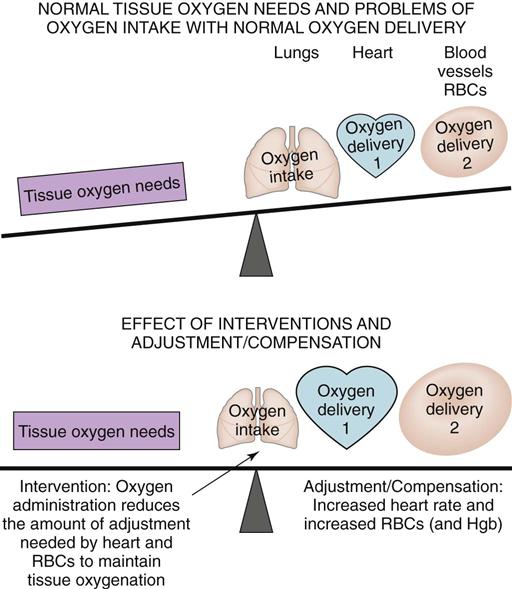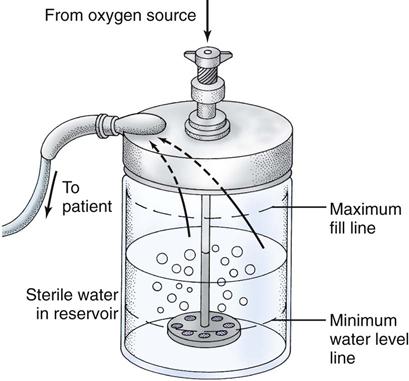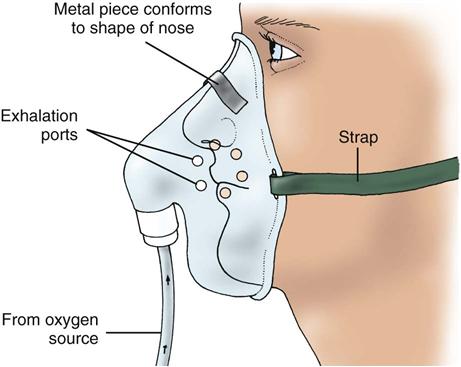Harry C. Rees
Care of Patients Requiring Oxygen Therapy or Tracheostomy
Learning Outcomes
Safe and Effective Care Environment
1 Act as a patient advocate for patients receiving oxygen or who have tracheostomies.
2 Protect from injury the patient receiving oxygen or who has a tracheostomy.
3 Use medical asepsis when providing tracheostomy care.
4 Verify safe use of appropriate oxygen delivery systems and tracheostomy equipment.
Health Promotion and Maintenance
Psychosocial Integrity
Physiological Integrity
10 Apply knowledge of anatomy to prevent aspiration in a patient with a tracheal tube.
11 Teach the patient and family about home management of oxygen therapy or tracheostomy.

http://evolve.elsevier.com/Iggy/
Animation: Pulse Oximeter
Animation: Suctioning
Answer Key for NCLEX Examination Challenges and Decision-Making Challenges
Audio Glossary
Concept Map Creator
Key Points
Review Questions for the NCLEX® Examination
Oxygen is essential for the life and function of all cells and tissues. Three systems—the respiratory system, the cardiovascular system, and the hematologic system—work together to ensure sufficient tissue perfusion with oxygen for cell survival and proper function (see Fig. 29-1). Oxygenation and tissue perfusion needs can be inadequate as a result of many problems with the lungs. When a respiratory problem interferes with adequate oxygenation, both the cardiac system and the hematologic system adjust (compensate) and work harder to restore balance and maintain oxygenation and tissue perfusion (Fig. 30-1). Oxygen therapy and the use of a tracheostomy are interventions that can help improve oxygenation and tissue perfusion and, at the same time, reduce the burden on the cardiovascular and hematologic systems.
Oxygen Therapy
Overview
Oxygen (O2) is a gas used as a drug for relief of hypoxemia (low levels of oxygen in the blood) and hypoxia (decreased tissue oxygenation). The oxygen content of atmospheric air is about 21%. Oxygen therapy is prescribed when the oxygen needs of the patient cannot be met by atmospheric or “room air” alone. It is used for both acute and chronic breathing problems that cause decreased blood and tissue oxygen levels as indicated by decreased partial pressure of arterial oxygen (PaO2) levels or by decreased arterial oxygen saturation (SaO2). Non-respiratory conditions, such as heart failure, sepsis, fever, some poisons, and decreased hemoglobin levels or poor hemoglobin quality, can affect oxygenation. These conditions increase oxygen demand, decrease oxygen-carrying capability of the blood, or decrease cardiac output. Their presence is an indication for oxygen therapy.
The purpose of oxygen therapy is to use the lowest fraction of inspired oxygen (FiO2) to have an acceptable blood oxygen level without causing harmful side effects. Although oxygen improves the PaO2 level, it does not cure the problem or stop the disease process. Most patients with some degree of hypoxia require an oxygen flow of 2 to 4 L/min via nasal cannula or up to 40% via Venturi mask. A patient who is hypoxemic and has chronic hypercarbia (increased partial pressure of arterial carbon dioxide [PaCO2] levels) needs lower levels of oxygen delivery, usually 1 to 2 L/min via nasal cannula, to prevent decreased respiratory effort. (A low PaO2 level is this patient’s primary drive for breathing.)
Patient-Centered Collaborative Care
Assessment
Arterial blood gas (ABG) analysis is the best measure for determining the need for oxygen therapy and for evaluating its effects. Oxygen need can also be determined by noninvasive monitoring, such as pulse oximetry.
Interventions
Before starting oxygen therapy and while caring for a patient receiving oxygen therapy, you must be knowledgeable about oxygen hazards and complications. Know the rationale and the expected outcome related to oxygen therapy for each patient receiving oxygen. Chart 30-1 lists best practices for patients using oxygen therapy.
Hazards and Complications of Oxygen Therapy
Combustion.
Oxygen itself does not burn, but it supports and enhances combustion. Therefore a fire burns better in the presence of oxygen. For example, when the oxygen content of the air around a lighted cigarette is nearly 50%, the entire cigarette flames up and can catch items nearby on fire (Edelman et al., 2008). Open fires, even small ones like candles or cigarettes, should not be in the same room during oxygen therapy. Take special precautions during oxygen delivery, including posting a sign on the door of the patient’s room. Smoking is prohibited in the patient’s room, including at home, when oxygen is in use.
All electrical equipment must be grounded to prevent fires from electrical arcing sparks. Grounded plugs may have three prongs or only two prongs with one prong being wider than the other. Grounded outlets in the hospital setting usually have a green or red dot on the plate. Frayed cords must be repaired because they can cause a spark that can ignite a flame. Flammable solutions (containing high concentrations of alcohol or oil) are not used in rooms in which oxygen is in use. (This does not include alcohol-based hand rubs.)
Oxygen-Induced Hypoventilation.
Assess for oxygen-induced hypoventilation in the patient whose main respiratory drive is hypoxia (hypoxic drive), such as in the patient with chronic lung disease who also has carbon dioxide retention (hypercarbia). The arterial carbon dioxide (PaCO2) level for these patients gradually rises over time. The central chemoreceptors in the brain (medulla) are normally sensitive to increased PaCO2 levels. When these receptors are active, they stimulate breathing and increase respiratory rate. When the PaCO2 increases gradually to above 60 to 65 mm Hg, this normal mechanism to trigger breathing no longer functions. The central chemoreceptors lose sensitivity to increased levels of PaCO2 and do not respond by increasing the rate and depth of respiration. This loss of sensitivity to high levels of PaCO2 is called CO2 narcosis. For these patients, the stimulus to breathe is a decreased arterial oxygen level. The low oxygen levels are sensed by peripheral chemoreceptors in the carotid sinus areas and aortic arch. When arterial oxygen (PaO2) levels drop (hypoxemia), these receptors signal the brain to increase the respiratory rate and depth; this is known as the hypoxic drive to breathe.
The hypoxic drive occurs only in the presence of severely elevated PaCO2 levels that have occurred slowly, over years (i.e., in the patient who has hypoxemia and hypercarbia). When the patient with low PaO2 levels and high PaCO2 levels receives oxygen therapy, the PaO2 level increases, removing the trigger for breathing, and the patient has respiratory depression. (The patient being ventilated mechanically is not at risk for this complication.)
Oxygen therapy is prescribed at the lowest liter flow (e.g., 1, 2, or 3 L/min) needed to manage hypoxemia. A system that delivers more precise oxygen levels (e.g., a Venturi mask) is preferred. However, a patient with chronic obstructive pulmonary disease may not tolerate a facemask.
Closely monitor the respiratory rate and depth while the patient is receiving oxygen. Monitoring is especially important when it is the first time he or she receives oxygen or when the PaCO2 levels are not known. Manifestations of hypoventilation are seen during the first 30 minutes of oxygen therapy. The patient’s color improves (from ashen or gray to pink) because of an increase in the PaO2 level before the apnea or respiratory arrest occurs from slower and shallow respirations. Therefore carefully monitor the level of consciousness, respiratory pattern and rate, and pulse oximetry for those at risk for oxygen-induced hypoventilation, apnea, and respiratory arrest. Although oxygen-induced hypoventilation is a serious concern, untreated or inadequately treated hypoxemia is a greater threat to life.
Oxygen Toxicity.
Oxygen toxicity is related to the concentration of oxygen delivered, duration of oxygen therapy, and degree of lung disease present. In general, an oxygen level greater than 50% given continuously for more than 24 to 48 hours may damage the lungs.
The causes and manifestations of lung injury from oxygen toxicity are the same as those for acute respiratory distress syndrome (ARDS) (see Chapter 34). Initial symptoms include dyspnea, nonproductive cough, chest pain beneath the sternum, and GI upset. As exposure to high levels of oxygen continues, the symptoms become more severe with decreased vital capacity, decreased compliance, crackles, and hypoxemia. Prolonged exposure to high oxygen levels damages lung tissues. Atelectasis, pulmonary edema, hemorrhage, and hyaline membrane formation result. Surviving this critical condition depends on correcting the underlying disease process and decreasing the oxygen amount delivered.
The toxic effects of oxygen are difficult to treat, making prevention a priority. The lowest level of oxygen needed to maintain oxygenation and prevent oxygen toxicity is prescribed. Closely monitor arterial blood gases (ABGs) during oxygen therapy, and notify the health care provider of PaO2 levels greater than 90 mm Hg. Also monitor the prescribed oxygen level and length of therapy to identify patients at higher risk. High oxygen levels are avoided unless absolutely necessary. The use of continuous positive airway pressure (CPAP) with an oxygen mask, bi-level positive airway pressure (BiPAP), or positive end-expiratory pressure (PEEP) on the mechanical ventilator (see Chapter 34) may reduce the amount of oxygen needed. As soon as the patient’s condition allows, the prescribed amount of oxygen is decreased.
Absorption Atelectasis.
Nitrogen in the air helps maintain patent airways and alveoli. Making up 79% of room air, nitrogen prevents alveolar collapse because it does not cross the alveolar-capillary membranes and remains in the airways and alveoli. When high oxygen levels are delivered, nitrogen is diluted, oxygen diffuses from the alveoli into the circulation, and the alveoli collapse. Collapsed alveoli cause atelectasis (called absorption atelectasis), which is detected by auscultation.
Drying of the Mucous Membranes.
When the prescribed oxygen flow rate is higher than 4 L/min, humidify the delivery system (Fig. 30-2). Ensure that oxygen bubbles through the water in the humidifier.
Oxygen can also be humidified via a large-volume jet nebulizer in mist form (aerosol). A heated nebulizer raises the humidity even more and is used for oxygen delivery through an artificial airway. Usually the upper airway passages warm the air during breathing, but these passages are bypassed with an artificial airway, such as an endotracheal tube.
For the patient to receive properly humidified oxygen, the humidifier or nebulizer must have a sufficient amount of sterile water and the flow rate must be adequate. Condensation often forms in the tubing. Remove this condensation as it collects by disconnecting the tubing and emptying the water. Minimize the time the tubing is disconnected because the patient does not receive oxygen during this period. Some humidifiers and nebulizers have a water trap that hangs from the tubing so that the condensation can be drained without disconnecting. Check the water level and change the humidifier as needed.
Infection.
The humidifier or nebulizer may be a source of bacteria, especially if it is heated. Pseudomonas aeruginosa is often the organism involved. Oxygen delivery equipment such as cannulas and masks can also harbor organisms. Change equipment as per policy or protocol, which ranges from every 24 hours for humidification systems to every 7 days or whenever necessary for cannulas and masks.
Oxygen Delivery Systems
Oxygen can be delivered by many systems. Regardless of the type of delivery system used, it is important to understand its indications, advantages, and disadvantages. Use the equipment properly, and ensure appropriate equipment maintenance. Consult a respiratory therapist whenever there is a question or concern about an oxygen delivery system.
The type of delivery system used depends on:
• Oxygen concentration required by the patient
• Oxygen concentration achieved by a delivery system
• Importance of accuracy and control of the oxygen concentration
Oxygen delivery systems are classified by the rate of oxygen delivery. There are two systems: low-flow systems and high-flow systems. Low-flow systems do not provide enough flow of oxygen to meet the total oxygen need and air volume of the patient. So, part of the tidal volume is supplied by breathing room air. The total level of oxygen inspired depends on the respiratory rate and tidal volume. High-flow systems have a flow rate that meets the entire oxygen need and tidal volume regardless of the patient’s breathing pattern. High-flow systems are used for critically ill patients and when delivery of precise levels of oxygen is needed.
If the patient needs a mask but is able to eat, request a prescription for a nasal cannula to be used at mealtimes only. Reapply the mask after the meal is completed. To increase mobility, up to 50 feet of connecting tubing can be used with connecting pieces.
Low-Flow Oxygen Delivery Systems.
Low-flow delivery systems include the nasal cannula, simple facemask, partial rebreather mask, and non-rebreather mask (Table 30-1). These systems are inexpensive, easy to use, and fairly comfortable. A disadvantage is that the actual amount of oxygen delivered varies and depends on the patient’s breathing pattern. The oxygen is diluted with room air (21% oxygen), which lowers the amount of oxygen actually inspired.
TABLE 30-1
COMPARISON OF LOW-FLOW OXYGEN DELIVERY SYSTEMS
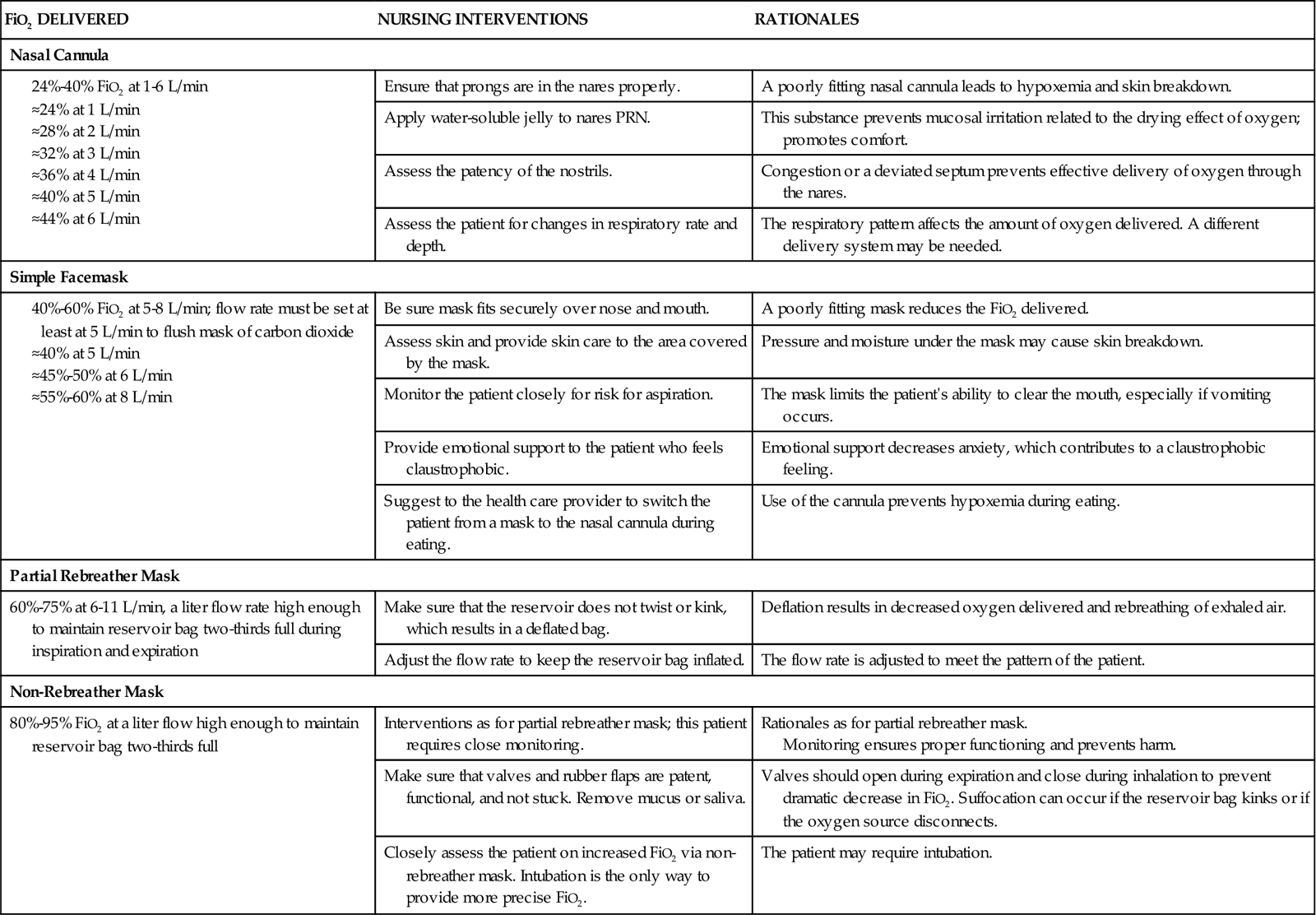
Nasal Cannula.
The nasal cannula, or nasal prongs (Fig. 30-3), is used at flow rates of 1 to 6 L/min. Oxygen concentrations of 24% (at 1 L/min) to 44% (at 6 L/min) can be achieved. Flow rates greater than 6 L/min do not increase oxygenation because the anatomic dead space (places where air flows but the structures are too thick for gas exchange) is full. In addition, high flow rates increase mucosal irritation.
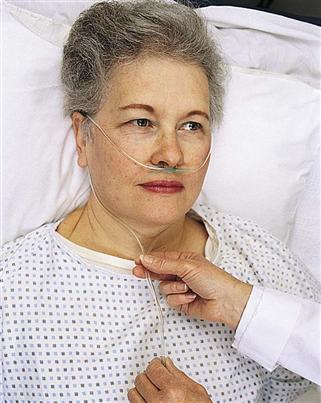
The nasal cannula is often used for chronic lung disease and for any patient needing long-term oxygen therapy. The patient who retains carbon dioxide is rarely prescribed to receive oxygen at a rate higher than 2 to 3 L/min because of the risk for losing the drive to breathe, thereby increasing the risk for apnea or respiratory arrest. Place the nasal prongs in the nostrils, with the openings facing the patient, following the natural anatomic curve of the nares.
Facemasks.
Facemasks for oxygen delivery can deliver a wide range of oxygen flow rates and concentrations.
Simple facemasks are used to deliver oxygen concentrations of 40% to 60% for short-term oxygen therapy or in an emergency (Fig. 30-4). A minimum flow rate of 5 L/min is needed to prevent the rebreathing of exhaled air. Ensure the mask fits well to maintain inspired oxygen levels. Care for the skin under the mask and strap to prevent skin breakdown.
Partial rebreather masks provide oxygen concentrations of 60% to 75% with flow rates of 6 to 11 L/min. It is a mask with a reservoir bag but no flaps (Fig. 30-5). With each breath, the patient rebreathes one third of the exhaled tidal volume, which is high in oxygen and provides a higher fraction of inspired oxygen (FiO2). Be sure that the bag remains slightly inflated at the end of inspiration; otherwise, the desired amount of oxygen is not delivered. If needed, call the respiratory therapist for assistance.
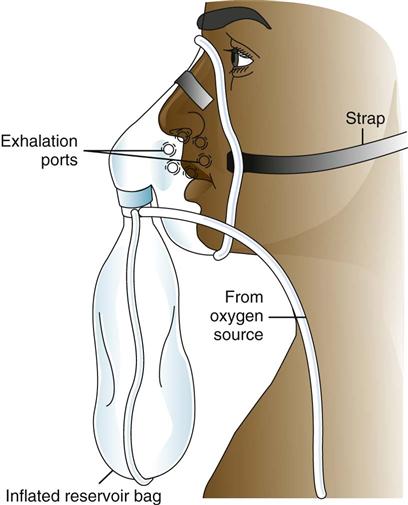
Non-rebreather masks provide the highest oxygen level of the low-flow systems and can deliver an Fio2 greater than 90%, depending on the patient’s breathing pattern. This mask is often used with patients whose respiratory status is unstable and who may require intubation.
The non-rebreather mask has a one-way valve between the mask and the reservoir and two flaps over the exhalation ports (Fig. 30-6). The valve allows the patient to draw all needed oxygen from the reservoir bag, and the flaps prevent room air from entering through the exhalation ports (room air would dilute the oxygen concentration). During exhalation, air leaves through these exhalation ports while the one-way valve prevents exhaled air from re-entering the reservoir bag. Some models include only one flap on the mask, or one of the exhalation flaps may be removed for safety purposes. The flow rate is kept high (10 to 15 L/min) to keep the bag inflated during inhalation. Assess for this safety feature at least hourly.
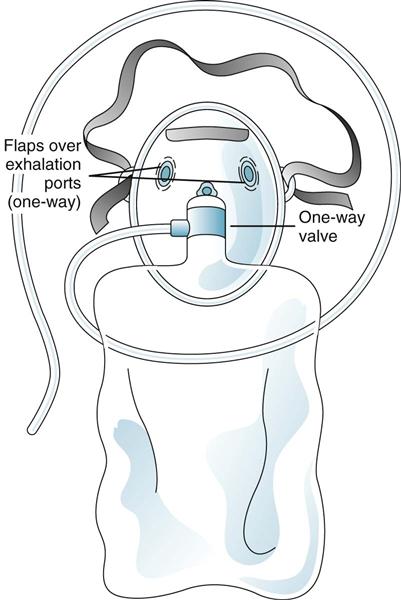
High-Flow Oxygen Delivery Systems.
High-flow systems (Table 30-2) include the Venturi mask, aerosol mask, face tent, tracheostomy collar, and T-piece. These devices deliver an accurate oxygen level when properly fitted. A high-flow system delivers oxygen concentrations from 24% to 100% at 8 to 15 L/min.
TABLE 30-2
COMPARISON OF HIGH-FLOW OXYGEN DELIVERY SYSTEMS
| FiO2 DELIVERED | NURSING INTERVENTIONS | RATIONALES |
| Venturi Mask (Venti Mask) | ||
| 24%-50% FiO2 with flow rates as recommended by the manufacturer, usually 4-10 L/min; provides high humidity | Perform constant surveillance to ensure an accurate flow rate for the specific FiO2. | An accurate flow rate ensures FiO2 delivery. |
| Keep the orifice for the Venturi adaptor open and uncovered. | If the Venturi orifice is covered, the adaptor does not function and oxygen delivery varies. | |
| Provide a mask that fits snugly and tubing that is free of kinks. | FiO2 is altered if kinking occurs or if the mask fits poorly. | |
| Assess the patient for dry mucous membranes. | Comfort measures may be indicated. | |
| Change to a nasal cannula during mealtime. | Oxygen is a drug that needs to be given continuously. | |
| Aerosol Mask, Face Tent, Tracheostomy Collar | ||
| 24%-100% FiO2 with flow rates of at least 10 L/min; provides high humidity | Assess that aerosol mist escapes from the vents of the delivery system during inspiration and expiration. | Humidification should be delivered to the patient. |
| Empty condensation from the tubing. | Emptying prevents the patient from being lavaged with water, promotes an adequate flow rate, and ensures a continued prescribed FiO2. | |
| Change the aerosol water container as needed. | Adequate humidification is ensured only when there is sufficient water in the canister. | |
| T-Piece | ||
| 24%-100% FiO2 with flow rates of at least 10 L/min; provides high humidity | Empty condensation from the tubing. | Condensation interferes with flow rate delivery of FiO2 and may drain into the tracheostomy if not emptied. |
| Keep the exhalation port open and uncovered. | If the port is occluded, the patient can suffocate. | |
| Position the T-piece so that it does not pull on the tracheostomy or endotracheal tube. | The weight of the T-piece pulls on the tracheostomy and causes pain or erosion of skin at the insertion site. | |
| Make sure the humidifier creates enough mist. A mist should be seen during inspiration and expiration. | An adequate flow rate is needed to meet the inspiration effort of the patient. If not, the patient will be “air-hungry.” | |
Stay updated, free articles. Join our Telegram channel

Full access? Get Clinical Tree


